Monday Feb. 27, 2006
Answers to the special assignment questions
that some students had to answer before retrieving Quiz #1.
1S1P Assignment #2 is due on Wednesday, Mar.
1. Optional Assignment #3 is due
Friday, Mar. 3.
The Quiz #2 Study Guide is now available.
As long as you are reading through these class notes, you might as well
give this surprise optional assignment
a try.
Here's the
picture of energy balance that we ended with last Friday.
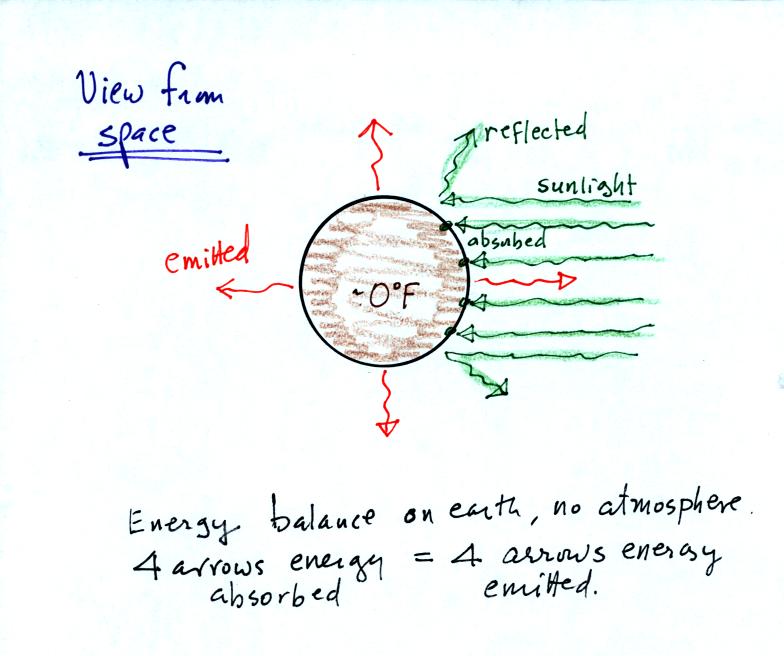
Energy balance on the earth without an atmosphere. Energy
absorbed by the earth (4 arrows of energy) is balanced by an equal
amount of emitted
energy (4 orange arrows). The two kinds of energy do not
need to be the
same.
Note the two units of reflected sunlight do not need to be balanced by
two units of emitted energy.
Now we will shift to a ground based view of the same situation.
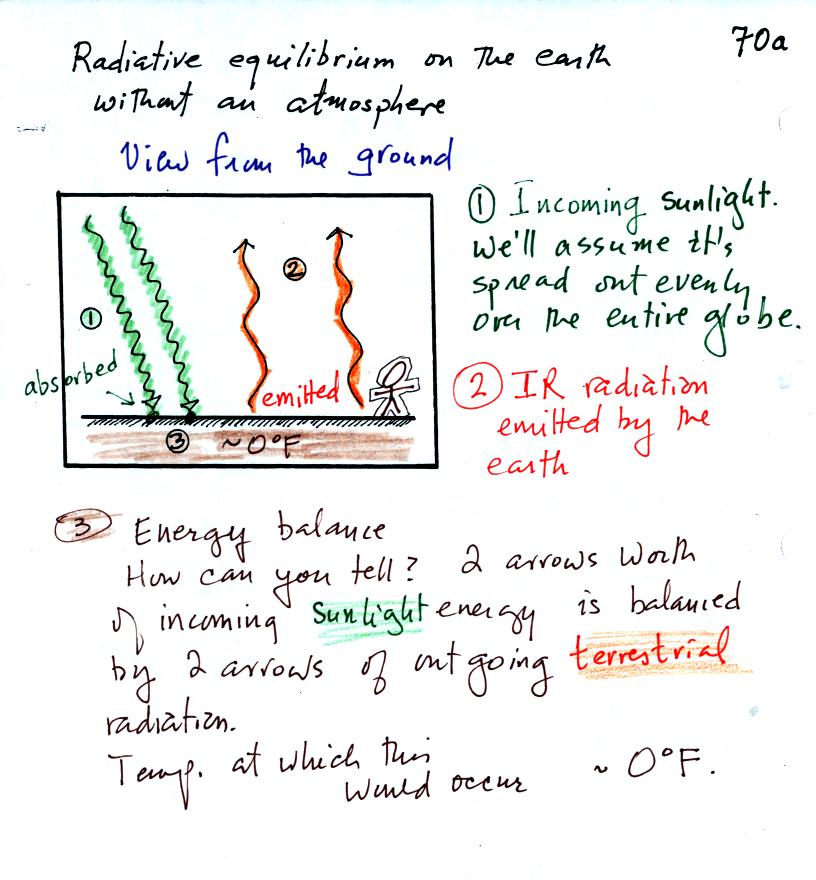
Don't let the fact that only two incoming arrows of energy are
balancing two arrows of outgoing energy (the last example used 4
arrows). The important thing is that equal amounts of energy are
being absorbed
and emitted.
Our next step will be to add the earth's atmosphere and see how that
affects energy balance. Before doing that however we need to
learn about how the atmosphere affects incoming sunlight (UV, VIS, and
IR radiation) and IR radiation emitted by the earth.
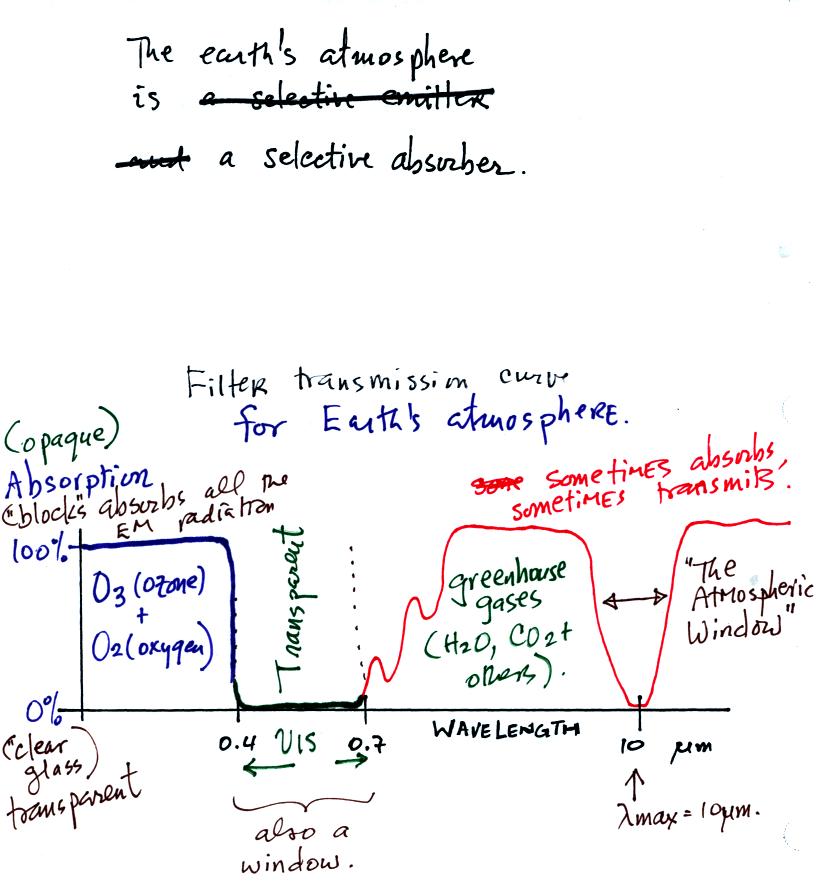
This is a slightly simplified representation of the filtering effect of
the atmosphere on UV, VIS, and IR light (found on p. 69 in the
photocopied notes, a more realistic version is reproduced on p.
70). 0% absorption means the atmosphere behaves like a window
made of clear glass that is transparent to light. The light can
pass freely through the window. 100% absorption on the other hand
means the atmosphere is opaque to light, it blocks the light by
absorbing it.
In our simplified representation oxygen and ozone make the atmosphere
pretty much a perfect absorber of UV light and perfectly
transparent to VIS light. Greenhouse gases make the atmosphere a
selective absorber of IR light. Note "the atmospheric window"
centered at 10 micrometers. Light emitted by the earth at this
wavelength will pass through the atmosphere. IR light emitted by
the earth at slightly different wavelengths will be absorbed by
greenhouse gases. It is this ability of H20, CO2,
etc to
selectively absorb certain wavelengths of IR light that is responsible
for the greenhouse effect.
Now we'll
see how adding an atmosphere can take us from the relatively simple
energy balance on p. 70a (in the photocopied notes) to the more complex
situation on p. 70b. This
explanation is more detailed and hopefully clearer than the discussion
in class.

Energy balance without an atmosphere is depicted above at left.
We will add an atmosphere to this picture. That is done in the
figure at right. We know that the atmosphere selectively absorbs
IR light, so we will let one of the arrows of IR emitted by the ground
pass through the atmosphere. The other arrow however will be
absorbed by greenhouse gases and isn't able to pass through the
atmosphere.
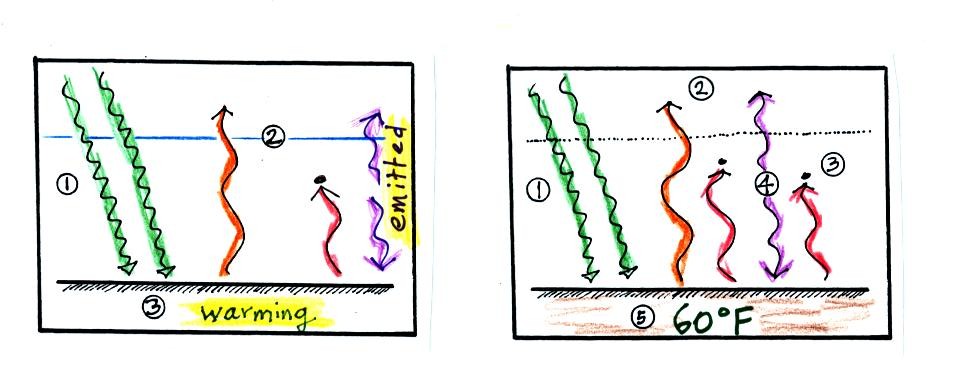
Because the atmosphere is absorbing energy it must also emit energy to
be in energy balance. The atmosphere emits IR radiation upward
into space and downward toward the ground. This is shown in the
figure above at left. Note that the ground is now absorbing more
energy (2 arrows of sunlight plus the additional energy from the
atmosphere)
than it is emitting (2 arrows). The ground will begin to
warm.
As the ground warms it will begin to emit more IR radiation. We
eventually end up with a new equilibrium shown above at right.
The ground is warmer (60 F) and is emitting 3 arrows of IR
energy. Let's have a careful look at all the numbered points in
this figure:
(1) There are two arrows of incoming sunlight.
We assume that all
of this sunlight is transmitted through the atmosphere and is absorbed
by the ground. We will examine how reasonable this is later.
(2) One
arrow of IR radiation is emitted by the ground at a wavelength
(10 micrometers) that is transmitted by the atmosphere (it passes
through the atmosphere into space)
(3) Two arrows of IR energy
emitted by the ground at slightly different
wavelengths are absorbed by greenhouse gases in the atmosphere.
(4) Two
arrows of IR energy are emitted by the atmosphere. One
arrow goes upward and into space, the second goes downward to the
ground where it is absorbed.
The greenhouse effect is this ability of the atmosphere to absorb some
of the IR energy emitted by the ground and then return some of that
energy to the ground. The ground is warm and is emitting more
energy (3 arrows) than it gets from the sun (2 arrows). It can
get away with this because it gets 1 arrow of energy back from the
atmosphere.
You can check for energy balance at several positions in the figure
above. First at the ground: 2 arrows of sunlight
+ 1 arrow
of IR from the atmosphere are begin absorbed. This is
balanced by three arrows of IR
being emitted by the ground. In
the atmosphere 2 arrows of IR
emitted by the ground are being absorbed. This is balanced by the 2 arrows of IR
radiation emitted by the atmosphere. Finally from a
position above the atmosphere. The energy arriving, 2 arrows of sunlight
is balanced by 2 arrows leaving (one from the ground
and one
from the atmosphere)

In our simplified version of the greenhouse effect we assumed that 100%
of the sunlight arriving at the top of the atmosphere passes through
the atmosphere and gets absorbed by the ground. The bottom figure
above shows that in reality only about 50% of the incoming sunlight
gets absorbed at the ground (168 units our of the total 342 units).
About 20% is absorbed by gases in the atmosphere (67 units out of the
total 342 units). Sunlight is a mixture of UV, VIS, and IR.
Ozone and oxygen will absorb a lot of the UV (though there isn't much
UV in sunlight) and greenhouse gases will absorb some of the IR
radiation in sunlight (there's a lot more IR in sunlight than UV).
The remaining 30% of sunlight is reflected by the ground, by clouds,
and even by air molecules themselves.
The simple
figure at the top of p. 72 in the photocopied
notes was meant to show you how the greenhouse effect works.
Now for a more realistic and more complete depiction of energy balance
on the earth.This
is the busy figure at the bottom of p. 72 is more complete and more
realistic. Now because you know something about what happens
to sunlight arriving at the earth and passing through the atmosphere
and because you know about what can happen to IR radiation emitted by
the earth, you should be able to identify each of the various parts of
the figure and should be able to check for energy balance.
We'll
start with the atmosphere
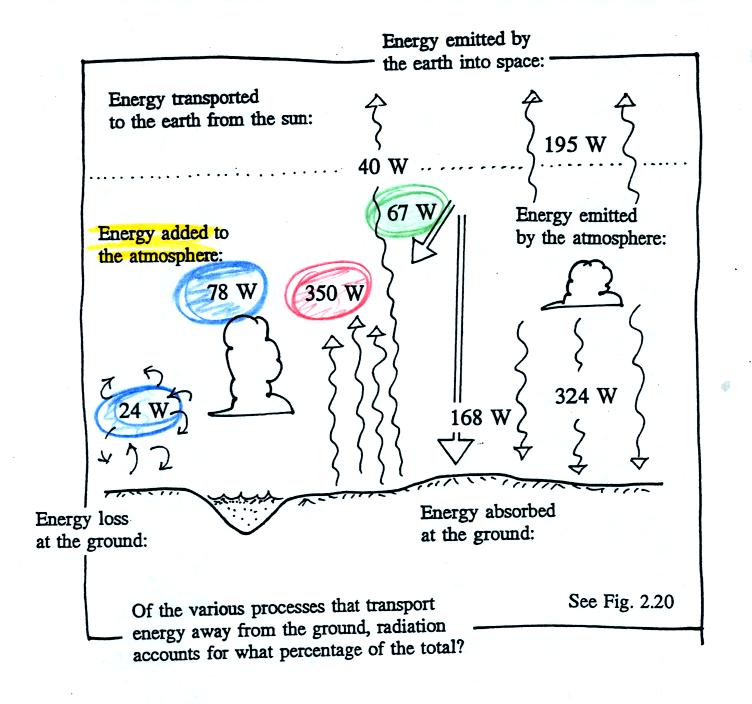
Energy being added to the atmosphere is shown in the figure
above. Moving from left to right, 24 units are transported from
the ground to the atmosphere by conduction and convection. 78
units are transported by latent heat. 350 units of IR radiation
emitted by the ground are absorbed by the atmosphere. 67 units of
sunlight are absorbed from the atmosphere. That is a total of 519
units of energy.
The figure below shows the atmosphere emitting 195 units of energy
upward into space and 324 units of energy downward toward the
ground. That is a total of 519 units which means the atmosphere
is in energy balance.
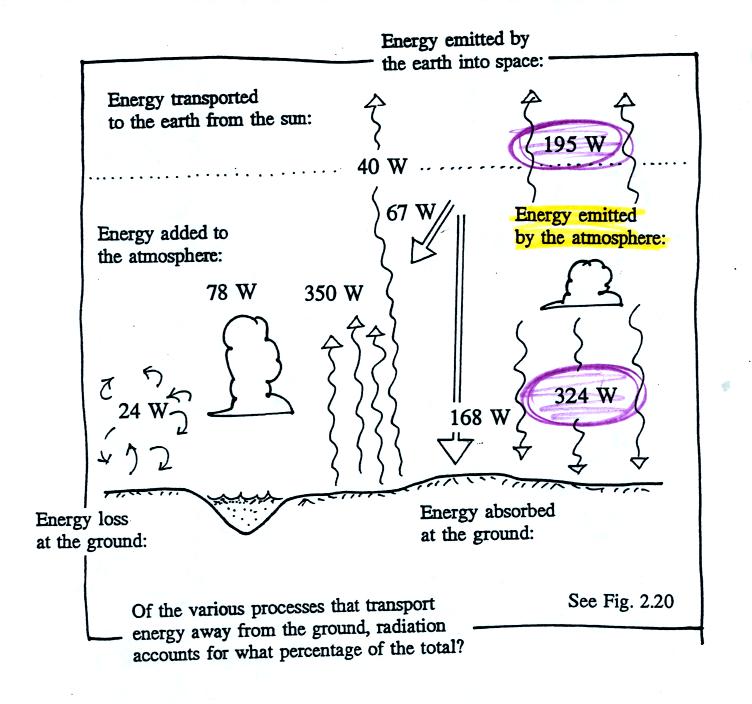
Why is there more downward energy emitted by the atmosphere than upward
energy? One explanation would be that the upper atmosphere is
colder than the lower atmosphere. Warm objects emit more energy
than cold objects.
Now the
ground
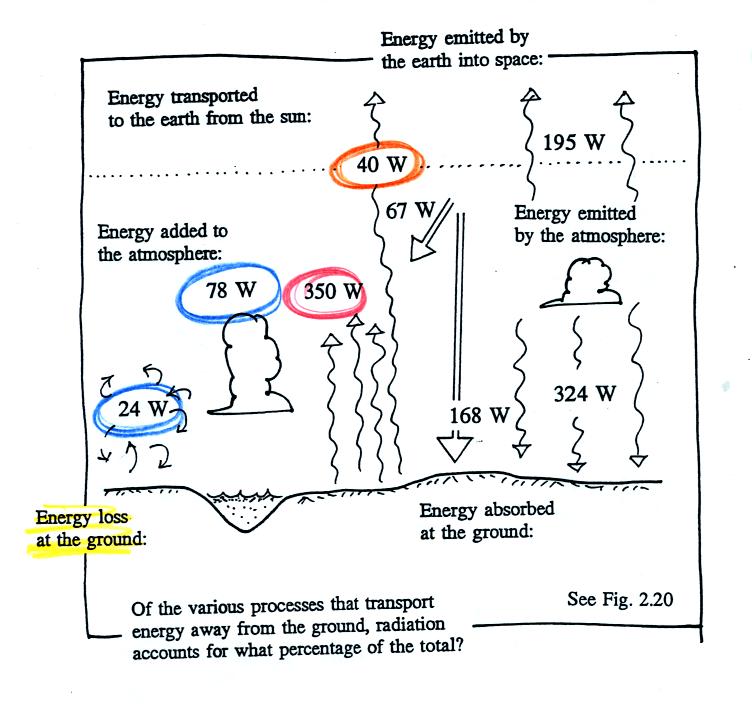
Conduction and convection transport 24 units of energy away from the
ground, latent heat transport another 78 units (3 times as much as
conduction and convection). The ground emits 350 + 40 units of IR
radiation. That is a grand total of 492 units.
In the figure below 168 units of sunlight energy and 324 units of IR
energy emitted by the atmosphere are absorbed by the ground. The
total, 492 units, balances what is lost by the ground. Note that
the ground gets about two times as much energy from the atmosphere (324
units) as it gets from the sun (168 units).
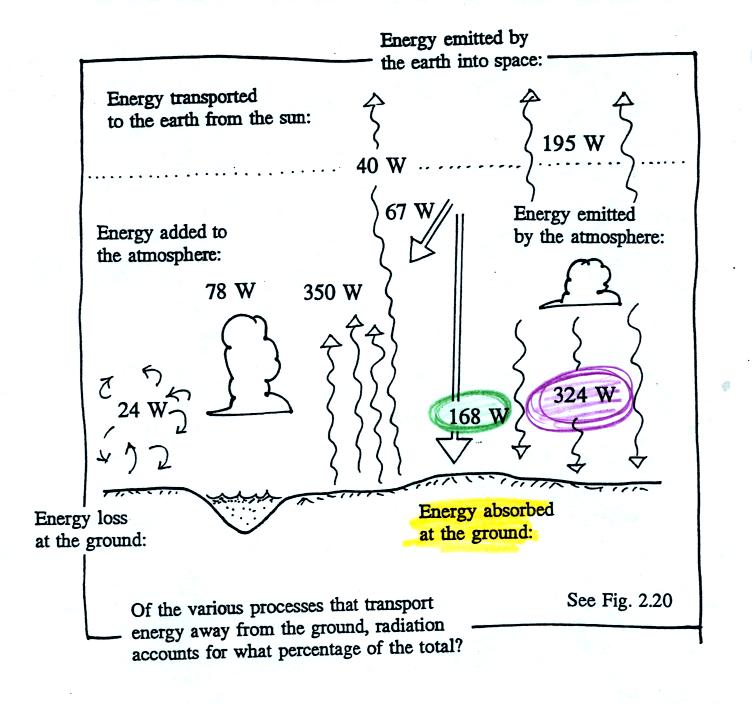
Now from a
vantage point above the earth's atmosphere
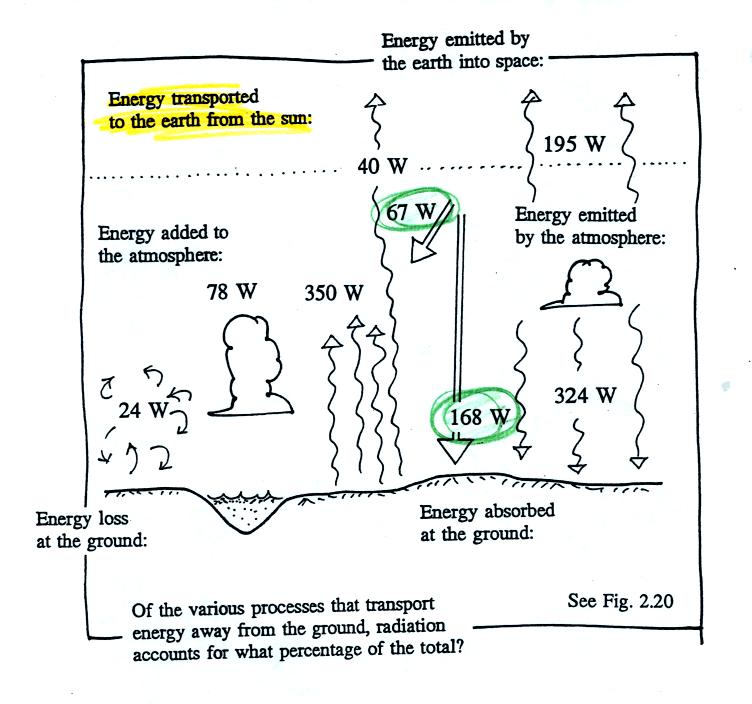
There are 67 + 168 units of sunlight energy arriving at the earth (see
figure above).
This is balanced by 40 (emitted by the ground) + 195 units of energy
(emitted by the atmosphere) leaving the earth. So we are in
energy balance there also.
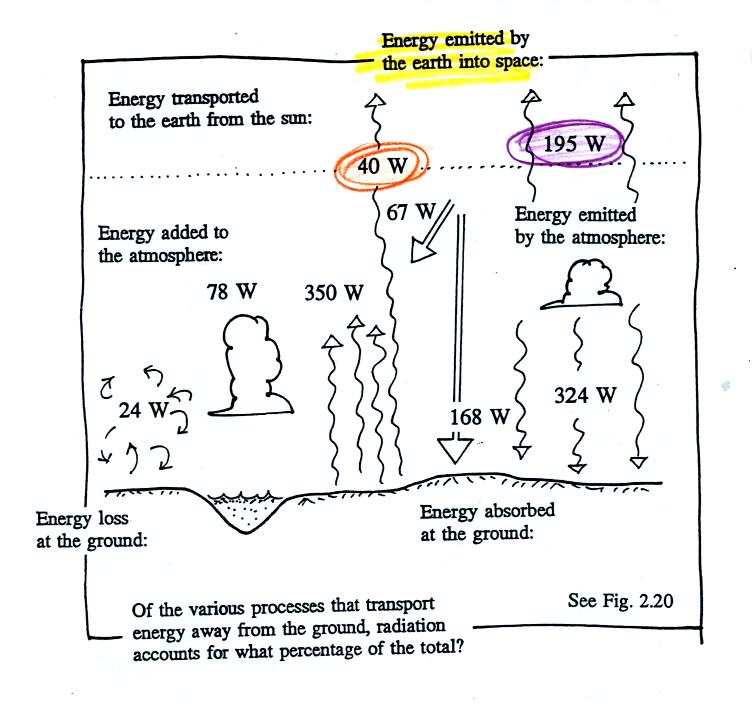
One final
question
The ground loses a total of 492 units of energy (24+78+350+40).
390 units (350+40) of this is IR radiation. IR radiation
accounts for about 80% of the total amount of energy transported away
from the ground.












